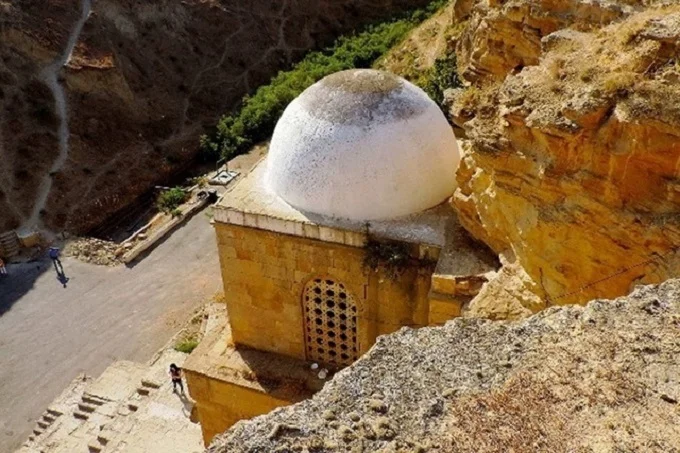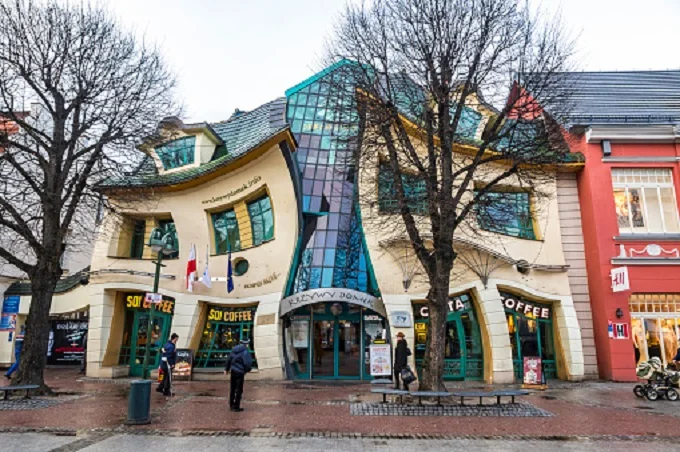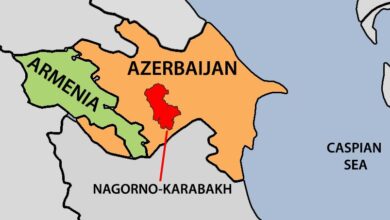Mysterious Diri-Baba: a remarkable relic of ancient architecture in Azerbaijan

There are many examples of old architecture to be found in Azerbaijan, some of which are completely one of a kind. The tomb of Diri-Baba may be found near Maraz, not too far away from Shamakhi. It is one of these constructions. It is one of a kind due to the fact that it serves as a tomb, a mosque, and a feast at the same time. It gives off the impression of being highly authoritative while yet being quite welcoming. In addition to that, the structure’s construction is rather peculiar.
Mounted in a rock at a significant elevation, this mausoleum has the appearance of being suspended in the air.
The whole name of the architect who designed and constructed this one-of-a-kind mausoleum that is unlike any other has not been recorded. The only part of his name that remained was his middle name: ustad Haji oglu. On one of the stones that were incorporated into the structure, it was discovered that there was a piece of this inscription. The same inscription also makes it very evident that the tomb was constructed in the year 1402, so take that as you will.
It is said that a saint by the name of Diri-Baba, who was described as a living immortal elder, was laid to rest here and did not decompose for a very long period.
Since the 17th century, the tomb has been the subject of a wide variety of myths, stories, and other supernatural accounts. It is a popular destination for pilgrims and tourists alike, as well as scientists who are intrigued by the enigma surrounding it. In their journals, travelers spoke of a carved frieze placed between the tiers, tromps embellished with a stylized floral adornment with interlacing calligraphic inscriptions and other architectural features.
Engelbert Kaempfer (1651-1716) was a German doctor, traveler, and naturalist. He is known to have visited the Diri-Baba tomb in Shamakhi, as well as Baku and other towns. He left behind some very interesting drawings.

The Dutch artist Cornelius de Bruin drew pictures of the tomb between 1703 and 1707 when he was traveling through these countries. He later included one of these drawings in the album book he kept of his work.
Ivan Bartolomey and Bernhard Dorn, two of the most prominent Russian archaeologists working in the Caucasus during the 19th century, conducted a detailed investigation of the tomb of Diri-Baba. Dorn was able to provide evidence indicating that the tomb was constructed during the reign of Shirvanshah Ibrahim I. (1382-1417).
Sheikh Haji Salah ad-Din “withdrew from the world and was engaged in prayer in this tomb,” according to the writings of the well-known Turkish traveler Evliya Chelebi, who visited the mausoleum in the early part of the year 1647. He told Chelebi that the person who was buried, who the locals called Diri-baba or Marazinsky sheikh, had lived during the reign of Shirvanshah Ibrahim I and had held the position of azanchi – muezzin at the court of the Shirvanshahs. He said that the buried person had been a muezzin at the court of the Shirvanshahs.
On the same day, December 27, 1636, the German traveler Adam Olearius also stopped at this location. In the notebook titled “Journey to Muscovy and Persia,” he wrote the following:
Olearius described him as follows in his writing: “… He looks to be incorruptible on his knees, clad in a gray caftan, and as if praying.” – It seems as though his former scribe, Seyid-Ibrahim, petitioned God to perform this miracle so th at his instructor, both in life and after death, would always appear to be fervently praying. This would be true whether the teacher was alive or dead…. Every year this gray caftan is put on a white one, and the old one is divided into parts and given out to pilgrims: at certain times people from afar make pilgrimages here, often on foot. The inhabitants have told many incredible things about these two saints…
The following phrase was written in Arabic over the entrances of this cemetery: “Oh God, open this door!”
Around the burial site of Tiri-babba (as in Olearius – O.B.) on the same mountain, various caves and closets were carved. Pilgrims halt in these locations and offer sacrifices inside of them. Some of them were situated at such a great height above the earth that it was physically impossible to get inside them without the use of a ladder… It had a manger, as well as four roomy apartments, places for beds, and other furniture that had been cut out of the rock. We were taken aback when we saw tiny shells strewn throughout the solid rock at the vaults, and we noted that other parts of the rock seem to have been constructed entirely out of shells and sand in other areas. When we were driving out from the Caspian Sea, we came across whole mountains with large, solid boulders of this sort.
Olearius also referenced the tomb of Saint Seid-Ibrahim, who was a follower of Diri-Baba, saying that “…Tamerlane, who destroyed everything in these locations, did not harm him.” It had the appearance of a castle, complete with stone walls and two inner courtyards, and it was constructed and furnished in that style.
Tamerlane traveled through this region between the years 1400 and 1403, as a side note. As a result, we may draw the following conclusion: the tomb of Seid-Ibrahim was already in existence by the turn of the 14th century. When did the tomb of his instructor Diri Baba first come into existence? Most likely a great deal sooner. And we are not referring to the tomb that was constructed in 1402 but rather to the ancient grotto that was cut into the rock. This is where he retired, maybe even while he was still alive.
Boris and Semyon Pazukhins were the first people to describe this grotto. They did so in 1669, after receiving an order from Tsar Alexei Mikhailovich to “go to Bukhara, Yurgench (Urgench), and Balkh to ransom the captured Russian people, collect information about the routes to India, and, as well as about the relics of the holy martyr Simeon…” Boris and Semyon Pazukhin.
The Pazuhins arrived in Shamakhi in 1672 and discovered that the “church” they had been looking for was really a mausoleum known as Pir-Magomed or Pir-Maraza. Within these structures are the relics of a Muslim saint. They said that the space that housed the shrine (urn) that contained the saint’s remains was “enclosed with a slotted stone,” which refers to stone slabs that had shebeke slots cut into them.
There are many who claim that Magomed is really Diri Baba. In general, there is a great deal of mystery connected to this tomb. For instance, why, in defiance of all the norms that have been established in the history of Islamic design, the most important aspect of this mosque is not the first but the second floor?
But first things first, it is not quite obvious why the tomb is located in such a remote area, in the middle of a canyon. Why was it concealed at that spot? After all, it was traditional to construct mausoleums on hillsides, where they could be seen from a greater distance. Perhaps the decedent, who did not want to draw attention to himself during his life, made this decision in his will. Or did he just wish to spend more time in the great outdoors? Or maybe it’s because the two-story structure was simply appended to the grotto that was already carved out of the rock at a later date.




